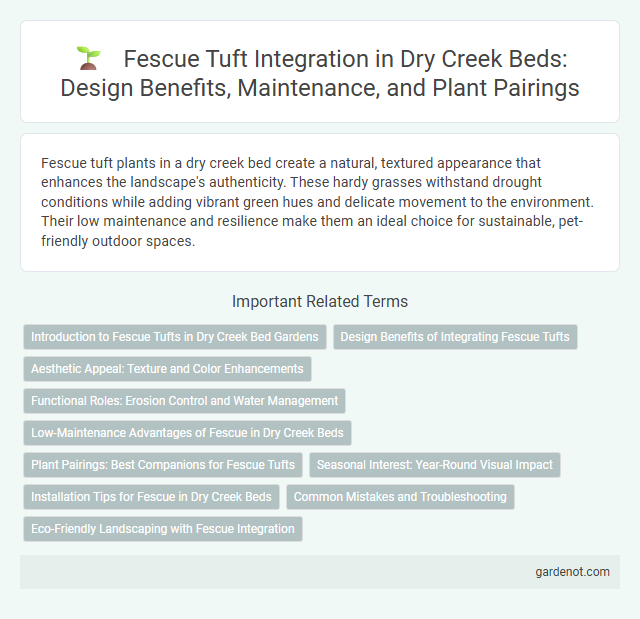Fescue tuft plants in a dry creek bed create a natural, textured appearance that enhances the landscape's authenticity. These hardy grasses withstand drought conditions while adding vibrant green hues and delicate movement to the environment. Their low maintenance and resilience make them an ideal choice for sustainable, pet-friendly outdoor spaces.
Introduction to Fescue Tufts in Dry Creek Bed Gardens
Fescue tufts in dry creek bed gardens provide drought-resistant ground cover that stabilizes soil and reduces erosion. Their fine, needle-like leaves create textured green clusters that thrive in well-drained, sandy, or rocky soils typical of arid landscapes. Incorporating Festuca species enhances biodiversity while requiring minimal irrigation, making them ideal for sustainable xeriscaping designs.
Design Benefits of Integrating Fescue Tufts
Fescue tufts enhance dry creek bed designs by stabilizing soil with their dense root systems, reducing erosion effectively. Their drought tolerance ensures low maintenance while adding natural texture and visual interest to landscape features. Integrating fescue tufts supports sustainable water management by facilitating natural drainage and minimizing runoff.
Aesthetic Appeal: Texture and Color Enhancements
Fescue tuft grasses enhance dry creek beds with their fine, dense texture and rich blue-green hues, creating a visually appealing contrast against rocky landscapes. Their clumping growth habit adds depth and dimension, softening harsh lines and providing seasonal color variation from vibrant green in spring to subtle bronze in fall. This combination of texture and color makes Fescue tuft an ideal plant for elevating the natural beauty of xeriscaped environments.
Functional Roles: Erosion Control and Water Management
Fescue tufts in dry creek beds play a crucial role in erosion control by stabilizing soil with their dense root systems, reducing sediment runoff during heavy rainfall. Their extensive roots enhance water infiltration, promoting groundwater recharge and moderating surface water flow. These functional traits support sediment retention and maintain the structural integrity of dry creek ecosystems.
Low-Maintenance Advantages of Fescue in Dry Creek Beds
Fescue tufts thrive in dry creek beds due to their deep root systems, which enhance drought tolerance and reduce irrigation needs. Their dense growth habit minimizes soil erosion and suppresses weed invasion, lowering maintenance efforts. These hardy grasses adapt well to variable soil conditions, providing long-lasting, sustainable ground cover in arid landscapes.
Plant Pairings: Best Companions for Fescue Tufts
Fescue tufts thrive when paired with drought-tolerant plants such as sedum, blue grama, and yarrow, which complement their fine texture and drought resistance in dry creek beds. These companions enhance erosion control and biodiversity by stabilizing soil and attracting pollinators, creating a balanced and sustainable landscape. Incorporating native grasses and flowering perennials alongside fescue tufts maximizes ecological benefits and visual appeal in arid environments.
Seasonal Interest: Year-Round Visual Impact
Fescue tuft provides year-round visual interest in dry creek beds with its evergreen blue-green foliage and fine-textured blades. Its drought tolerance and minimal maintenance make it ideal for sustained aesthetic appeal through seasonal changes. The plant's tufted growth habit adds dynamic texture and structure, enhancing the natural look of arid landscapes.
Installation Tips for Fescue in Dry Creek Beds
When installing fescue tuft in dry creek beds, ensure the soil is well-drained and slightly amended with organic matter to promote root establishment. Space tufts 6 to 12 inches apart to allow proper air circulation and reduce erosion risk during heavy runoff. Water newly planted fescue lightly but consistently for the first few weeks to support healthy growth before transitioning to natural rainfall.
Common Mistakes and Troubleshooting
Common mistakes when growing fescue tufts in a dry creek bed include overwatering, which can lead to root rot, and planting in poorly drained soil that retains excessive moisture. Troubleshooting involves ensuring well-drained, sandy or gravelly soil conditions to mimic natural dry creek environments, and adjusting watering schedules to prevent water accumulation. Monitoring for pests like aphids and addressing nutrient deficiencies with balanced fertilization promotes healthy fescue tuft growth.
Eco-Friendly Landscaping with Fescue Integration
Fescue tuft thrives in dry creek beds, providing an eco-friendly landscaping solution that enhances soil stabilization and reduces erosion. This drought-tolerant grass requires minimal irrigation, promoting water conservation in arid environments. Integrating fescue tufts into dry creek bed designs supports native biodiversity and sustainable land management practices.
Fescue tuft Infographic

 gardenot.com
gardenot.com